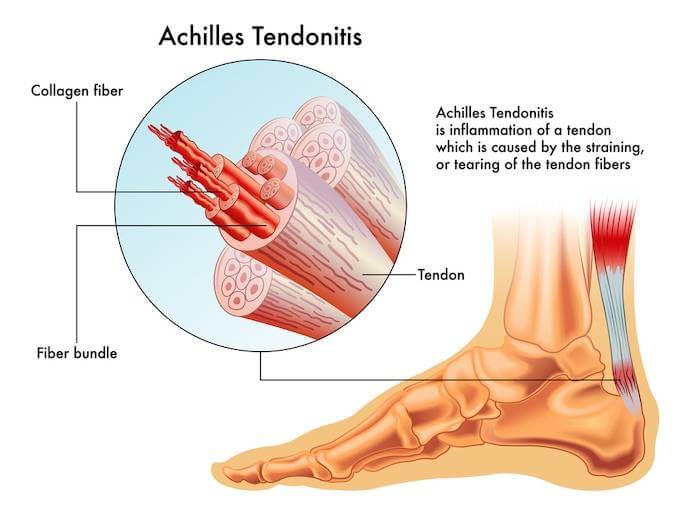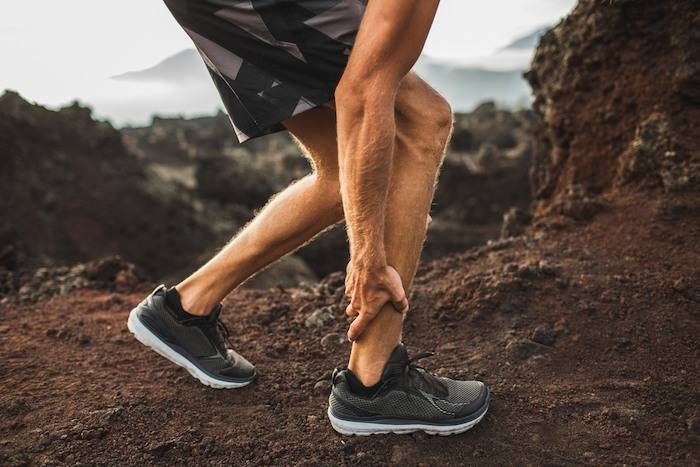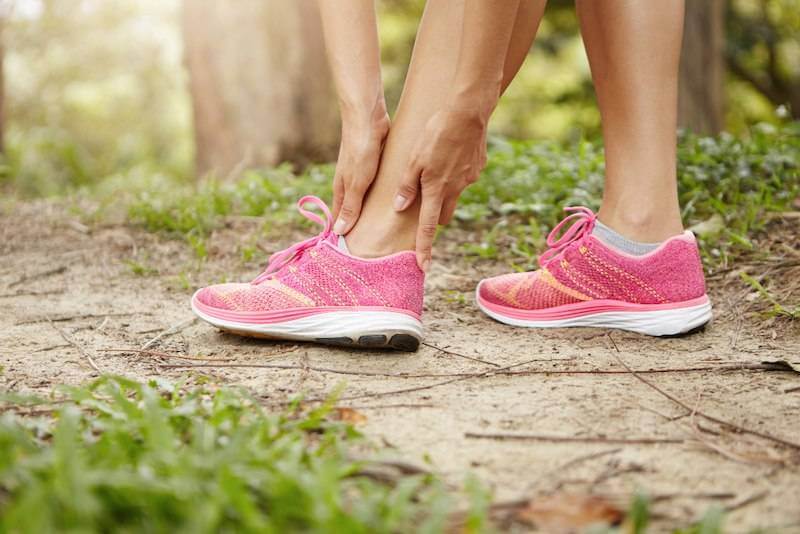What is the Achilles heel or Achilles tendon?
The Achilles tendon, more commonly known as the Achilles heel, is an elongated, fibrous tendon measuring approximately 15 cm in length, located at the back of the lower leg. Its role is to connect the calf muscles (Gastrocnemius and Soleus) to the heel bone, actively participating in the overall movement process. For this reason, it is said that this tendon is the strongest tendon in the human body.
The importance of the Achilles tendon for the human body
The significant role of the Achilles heel in proper human function is evidenced by the fact that this tendon enables us to move our feet and stand firmly on a solid surface.

The Achilles tendon allows the calf muscles to rotate the foot around the ankle joint, and during movement or standing, it transmits the force of the muscles to the foot. This way, activities such as running, jumping, walking, and even tiptoeing can be carried out thanks to the Achilles tendon.
Achilles Tendonitis Treatment at Fizionova Center - Expertise and Reliability in One Place
Every treatment involves a professional approach to the problem and the establishment of a correct diagnosis, which you can obtain at our Fizionova Center. Thanks to our skilled and courteous doctors, no health condition is left to chance.
For the complete implementation of the treatment, a thorough and detailed examination is conducted at Fizionova to discover the true causes of discomfort. In the case of Achilles tendonitis, a detailed medical history, overall health status, as well as the frequency of injuries and participation in sports activities are taken into account. The accuracy of the diagnosis is confirmed through additional imaging and examinations, using X-rays, scans, or magnetic resonance imaging, leading to the final decision on the treatment method. Treatment methods are carried out following protocol number 14 and protocol number 614, using the latest FSWT-focused shockwave therapy, which is successfully applied in the treatment of inflammatory conditions of the Achilles tendon.
Application of FSWT Therapy in Achilles Tendon Treatment - The most advanced treatment method available only at Fizionova Center
Focused Shockwave Therapy (FSWT) represents the latest method for treating, regenerating, and rehabilitating the musculoskeletal system. It is administered using a special FSWT device that emits high-energy acoustic waves and directs them toward painful areas, enabling muscle, tendon, and bone regeneration, reducing recovery time, and significantly alleviating pain. The high success rate of the FSWT device is supported by an increasing number of satisfied Fizionova Center users.
Achilles Tendon Injuries
The Achilles tendon is often prone to injury, with issues becoming more common in individuals over the age of thirty. Athletes who engage in intensive running are more susceptible to Achilles tendon injuries, but injuries can also occur in recreational athletes due to inadequate warm-up or training on hard surfaces (such as concrete, artificial turf, frozen ground, etc.), as well as poor-quality footwear. Individuals with flat feet may also suffer from various inflammatory conditions in the Achilles heel due to constant tension in the tendon.

Problems arising from Achilles tendon injuries can be acute or chronic, appearing as inflammation or tendon rupture.
What are the symptoms of Achilles tendon inflammation?
Achilles tendon inflammation involves an inflammatory process and degeneration of the tendon tissue itself. If Achilles tendon inflammation persists, it can alter the normal structure of the tendon, weakening its function. If left untreated, it can lead to tendon rupture.
Depending on the duration and the level of stress an individual experiences during training, Achilles tendon inflammation can be acute or chronic. During intense training and rapid increases in physical stress within a short period, immediate inflammation of the Achilles heel may occur. However, if the Achilles tendon is subjected to prolonged stress, inflammation becomes chronic.
Symptoms of Achilles tendon inflammation can gradually develop, manifesting as increased sensitivity and mild pain in the back of the lower leg or above the heel. With more intense strain on the Achilles tendon, the pain becomes more severe, and swelling around the tendon can occur, especially in elite athletes after long workouts. In cases of chronic Achilles tendon inflammation, morning stiffness may occur, making movement difficult.
Causes of Achilles Heel Inflammation
Achilles tendon inflammation is specific to individuals prone to prolonged and intense training, such as running, jumping, and similar sports activities. The condition occurs when issues manifest closer to the muscle.
In addition to athletes, the natural weakening of the Achilles tendon is associated with the ageing process, where problems arise in the part of the tendon closer to the heel bone (heel spur). Therefore, individuals at increased risk of Achilles heel inflammation can be categorized based on:
- Physical characteristics: flat feet, obesity, tight muscles in the back of the lower leg.
- Gender and age: individuals in middle age, predominantly males, are at higher risk.
- Chronic conditions: diabetics and those with high blood pressure, as well as individuals with rheumatoid arthritis and osteoarthritis.
- Medication use: some types of antibiotics can trigger Achilles heel inflammation.
- Intensive training: prolonged running or engaging in sports activities without proper warm-up can exert excessive stress on the tendon.
- Inadequate training conditions: running or jumping in low-quality footwear, on steep or hard surfaces, and cold weather negatively affect muscle and tendon conditions.
Achilles Tendon Rupture
Achilles tendon rupture is a more severe form of tendon injury. It occurs due to intensive training, when there are contractions in the calf muscles and when the pressure is transferred from the muscles to the Achilles heel or tendon. If this pressure persists for an extended period, tendon rupture is inevitable. The severity and degree of injury can vary, ranging from partial rupture to complete tendon rupture.
Professional sports, such as running, tennis, football, karate, etc., carry the risk of partial or complete Achilles tendon damage. Problems arise from sudden movements without proper warm-up, lack of conditioning, fatigue, and wearing uncomfortable footwear.
Symptoms of Achilles Tendon Rupture

Achilles tendon rupture can be a milder form of partial tendon rupture or a more severe complete rupture.
Partial Rupture
Partial or incomplete Achilles tendon rupture is more common and generally occurs after minor injuries or inadequately treated inflammations. Sudden, sharp pain of significant intensity is a common symptom, worsening with further stress on the Achilles heel. Swelling and tenderness at the site of the injury may occur.
Complete Rupture
Complete Achilles tendon rupture is marked by severe pain that paralyzes and prevents weight-bearing on the injured foot. The sound of tearing can be heard during the rupture, indicating a serious injury. Unlike partial rupture, which can be treated non-invasively with physical therapy, complete rupture requires urgent surgery, followed by various methods of therapy and rehabilitation.
Achilles Tendon Recovery
Recovering from Achilles tendon injuries requires a different approach, depending on the severity of the injury. Partial rupture, which is the milder form, usually does not require surgical intervention and can be successfully treated at Fizionova Center through precisely tailored exercises and physical therapy, along with the use of the latest FSWT device, which has proven to be very beneficial.
For complete rupture, surgical intervention is necessary, followed by physical therapy to restore the Achilles tendon's original function. During rehabilitation, various physical therapy methods are used, including cryotherapy, electrotherapy, laser therapy, kinesiotherapy, massage, hydrotherapy, and many others.
Returning to Normal and Athletic Activities After Injury
With the appropriate treatment, a return to normal life and activities can be achieved within three to four weeks, particularly for milder partial tendon ruptures. In the case of more serious injuries, recovery time is doubled. If surgical procedures were performed, the rehabilitation period is a minimum of two months, with full recovery expected within four months..
Put your health in the safe hands of the Fizionova team and walk again without pain!
Verify the results of our expert doctors, as each pain-free day is precious.
SCHEDULE A PHYSIATRIST'S EXAMINATION
Dr Jelena Kluz-Đurđević, a specialist in physical medicine
After a conversation with the patient, Dr. Jelena will conduct an examination to obtain a more comprehensive view of your health status, helping to determine whether it's an injury or a diagnosis.
The examination lasts for 30 minutes and includes:
Schedule a specialist examination by calling 011 2100 588 for the cost of 4,000 RSD.
